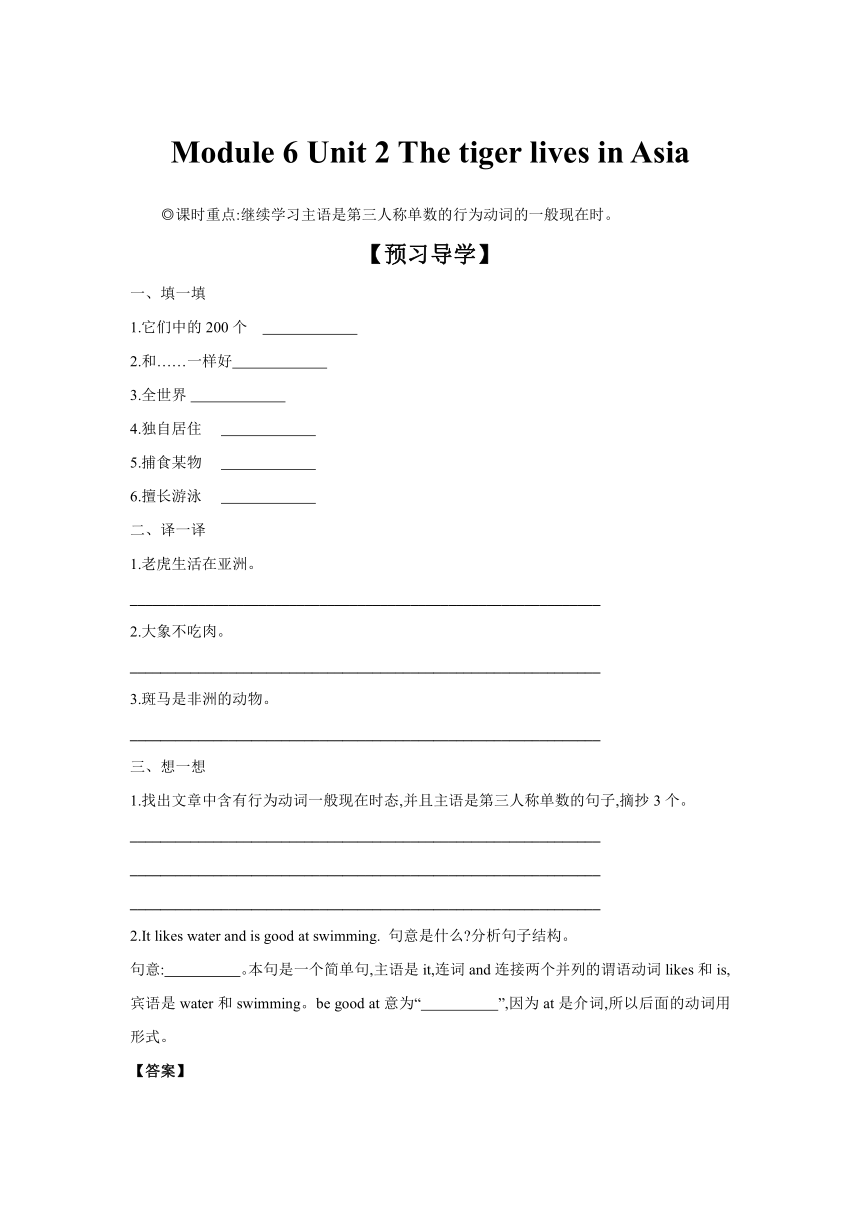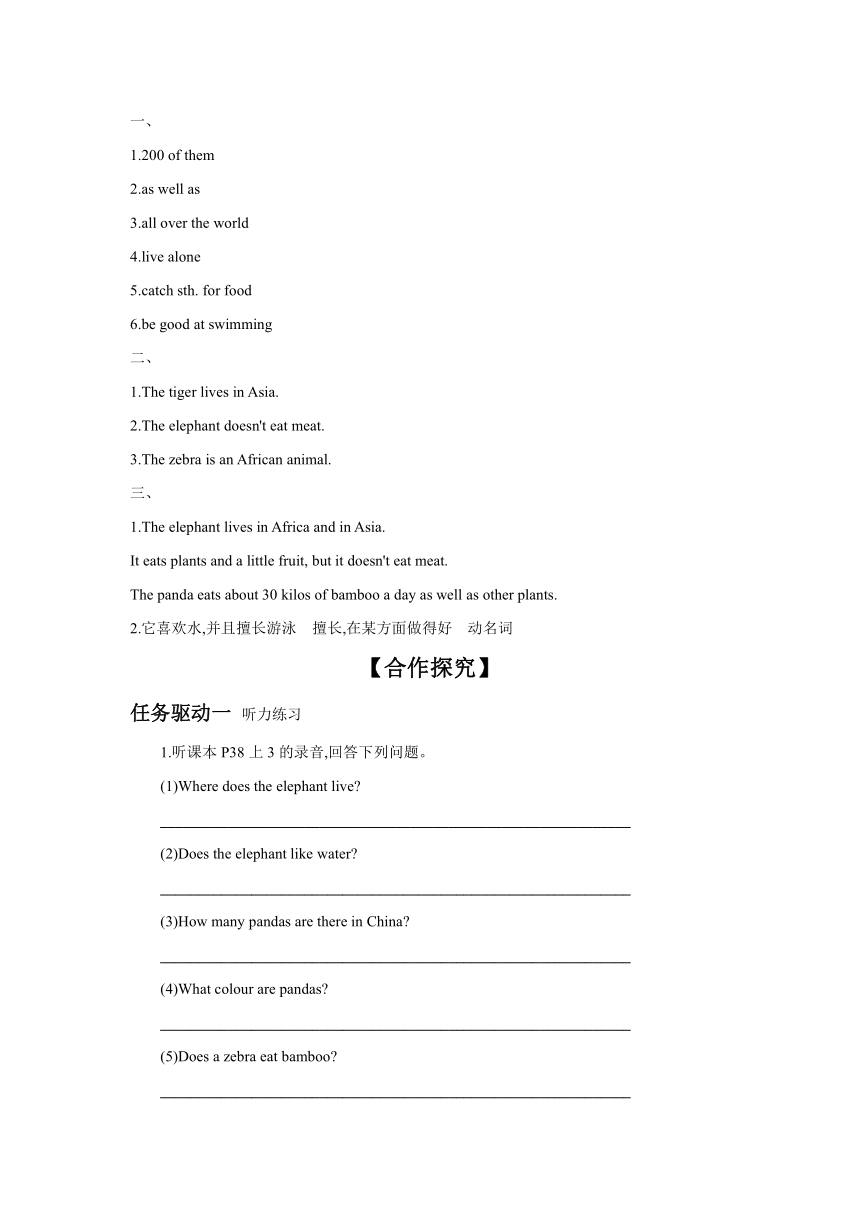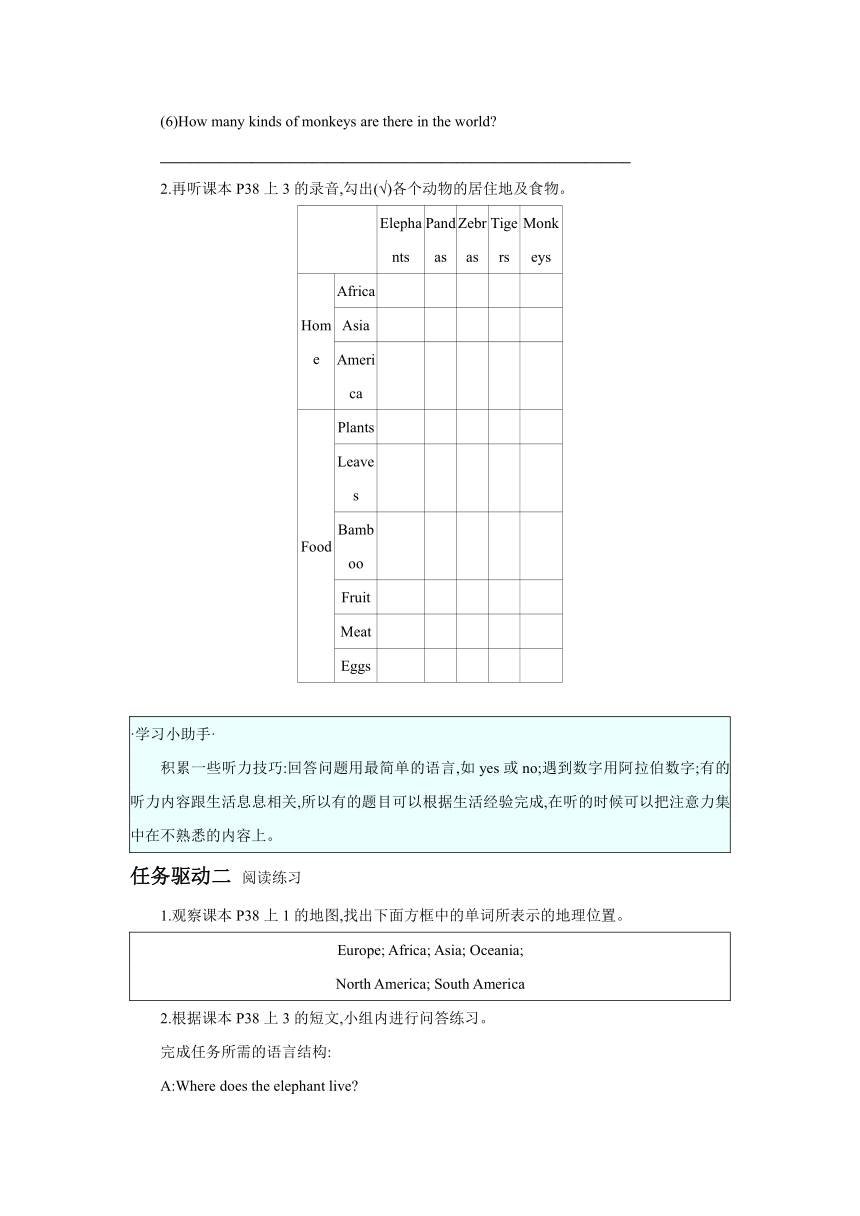Module 6 Unit 2 The tiger lives in Asia 学案初中英语外研版七年级上册(含答案)
文档属性
| 名称 | Module 6 Unit 2 The tiger lives in Asia 学案初中英语外研版七年级上册(含答案) |  | |
| 格式 | docx | ||
| 文件大小 | 26.8KB | ||
| 资源类型 | 教案 | ||
| 版本资源 | 外研版 | ||
| 科目 | 英语 | ||
| 更新时间 | 2024-02-28 07:23:22 | ||
图片预览



文档简介
Module 6 Unit 2 The tiger lives in Asia
◎课时重点:继续学习主语是第三人称单数的行为动词的一般现在时。
【预习导学】
一、填一填
1.它们中的200个
2.和……一样好
3.全世界
4.独自居住
5.捕食某物
6.擅长游泳
二、译一译
1.老虎生活在亚洲。
______________________________________________________________
2.大象不吃肉。
______________________________________________________________
3.斑马是非洲的动物。
______________________________________________________________
三、想一想
1.找出文章中含有行为动词一般现在时态,并且主语是第三人称单数的句子,摘抄3个。
______________________________________________________________
______________________________________________________________
______________________________________________________________
2.It likes water and is good at swimming. 句意是什么 分析句子结构。
句意: 。本句是一个简单句,主语是it,连词and连接两个并列的谓语动词likes和is,宾语是water和swimming。be good at意为“ ”,因为at是介词,所以后面的动词用 形式。
【答案】
一、
1.200 of them
2.as well as
3.all over the world
4.live alone
5.catch sth. for food
6.be good at swimming
二、
1.The tiger lives in Asia.
2.The elephant doesn't eat meat.
3.The zebra is an African animal.
三、
1.The elephant lives in Africa and in Asia.
It eats plants and a little fruit, but it doesn't eat meat.
The panda eats about 30 kilos of bamboo a day as well as other plants.
2.它喜欢水,并且擅长游泳 擅长,在某方面做得好 动名词
【合作探究】
任务驱动一 听力练习
1.听课本P38上3的录音,回答下列问题。
(1)Where does the elephant live
______________________________________________________________
(2)Does the elephant like water
______________________________________________________________
(3)How many pandas are there in China
______________________________________________________________
(4)What colour are pandas
______________________________________________________________
(5)Does a zebra eat bamboo
______________________________________________________________
(6)How many kinds of monkeys are there in the world
______________________________________________________________
2.再听课本P38上3的录音,勾出(√)各个动物的居住地及食物。
Elephants Pandas Zebras Tigers Monkeys
Home Africa
Asia
America
Food Plants
Leaves
Bamboo
Fruit
Meat
Eggs
·学习小助手·
积累一些听力技巧:回答问题用最简单的语言,如yes或no;遇到数字用阿拉伯数字;有的听力内容跟生活息息相关,所以有的题目可以根据生活经验完成,在听的时候可以把注意力集中在不熟悉的内容上。
任务驱动二 阅读练习
1.观察课本P38上1的地图,找出下面方框中的单词所表示的地理位置。
Europe; Africa; Asia; Oceania;
North America; South America
2.根据课本P38上3的短文,小组内进行问答练习。
完成任务所需的语言结构:
A:Where does the elephant live
B:It lives in Africa and in Asia.
A:What does the elephant eat
B:It eats plants, leaves, bamboo and a little fruit.
A:Does it eat meat
B:No, it doesn't.
...
3.根据你的个人情况,回答下列问题。
(1)What's your favourite animal
______________________________________________________________
(2)Where does it live
______________________________________________________________
(3)What kind of food does it eat
______________________________________________________________
·学习小助手·
需要注意助动词does和doesn't后接动词原形。
任务驱动三 写作练习
1.根据自己掌握的知识,完成课本P38上的2。
______________________________________________________________
______________________________________________________________
______________________________________________________________
______________________________________________________________
2.完成课本P39上的4。
______________________________________________________________
______________________________________________________________
3.完成课本P39上的5。
·学习小助手·
英语中需要大写的情况:句子第一个单词的首字母要大写;表示洲、国家、城镇、地名的词的首字母要大写。
【答案】
任务驱动一
1.(1)In Africa and in Asia.
(2)Yes, it does.
(3)About 1,800.
(4)Black and white.
(5)No, it doesn't.
(6)About 200 kinds of monkeys.
2.
Elephants Pandas Zebras Tigers Monkeys
Home Africa √ √ √
Asia √ √ √ √
America √
Elephants Pandas Zebras Tigers Monkeys
Food Plants √ √ √
Leaves √ √ √ √
Bamboo √ √
Fruit √ √
Meat √ √
Eggs √
任务驱动三
1.a.There are tigers in Asia.
b.There are elephants in Africa and in Asia.
c.There are zebras in Africa.
d.There are monkeys in Africa, Asia and America.
2.a little; kilos; grass; only; world; African
【知识超市】
●It eats plants and a little fruit. 它吃植物和一些水果。
句中的a little意为“一点儿”,修饰不可数名词,表示肯定意义;而单独的little也修饰不可数名词,但表示否定意义。
a few意为“一点儿”,修饰可数名词的复数形式,表示肯定意义; 而单独的few也修饰可数名词的复数形式,但表示否定意义。
[做一做]单项选择。
( )1.Each of us has friends. They can help us and play with us.
A.a little B.few C.a few D.little
( )2.—Can you speak English, Mr Wang
—Yes, but only .
A.little B.a little C.a few D.few
【答案】
1.C 2.B
●The panda eats about 30 kilos of bamboo a day, as well as plants and leaves.
熊猫除了植物和叶子外,每天还要吃30千克竹子。
句中的短语as well as意为“除……之外”,后面通常接名词或动名词。
1.as well as意为“也;还”,常用来连接两个并列的成分,通常不位于句首。它强调的是前一项,后一项只是顺便提及。因此连接并列主语时,谓语动词与前一项一致。翻译时要先翻译后面,再翻译前面。
2.as well as 用来表示同级之间的比较,意为“和……一样好”。注意:as well常用作状语,意为“又;也”,相当于too或also,常位于句末,无须用逗号与句子分开。
[做一做]单项选择。
( )1.They play all kinds of instruments (乐器) and sing .
A.also B.either C.as well D.as well as
( )2.Tom, Jane and Rose, to the farm on foot.
A.as long as; goes B.as well as; go
C.as long as; go D.as well as; goes
【答案】
1.C 2.D
●It's a very large animal and usually lives alone. 它是一种非常大的动物,通常独自居住。
live alone意为“独自居住”。feel lonely则意为“感到寂寞”。
[做一做]单项选择。
( )I don't have any close friends here. I feel sometimes (有时).
A.alone B.happy C.lonely D.proud (自豪的)
【答案】
C
●It likes water and is good at swimming. 它喜欢水,并且擅长游泳。
be good at意为“擅长……”,后接名词或动名词。该短语与do well in意思相同,可相互替换。注意:该短语中的be动词与句子的主语在人称与数上保持一致。
[做一做]同义句转换。
1.My father is good at swimming.
My father .
2.Are you good at English
you English
【答案】
1.does well in swimming
2.Do do well in
◎课时重点:继续学习主语是第三人称单数的行为动词的一般现在时。
【预习导学】
一、填一填
1.它们中的200个
2.和……一样好
3.全世界
4.独自居住
5.捕食某物
6.擅长游泳
二、译一译
1.老虎生活在亚洲。
______________________________________________________________
2.大象不吃肉。
______________________________________________________________
3.斑马是非洲的动物。
______________________________________________________________
三、想一想
1.找出文章中含有行为动词一般现在时态,并且主语是第三人称单数的句子,摘抄3个。
______________________________________________________________
______________________________________________________________
______________________________________________________________
2.It likes water and is good at swimming. 句意是什么 分析句子结构。
句意: 。本句是一个简单句,主语是it,连词and连接两个并列的谓语动词likes和is,宾语是water和swimming。be good at意为“ ”,因为at是介词,所以后面的动词用 形式。
【答案】
一、
1.200 of them
2.as well as
3.all over the world
4.live alone
5.catch sth. for food
6.be good at swimming
二、
1.The tiger lives in Asia.
2.The elephant doesn't eat meat.
3.The zebra is an African animal.
三、
1.The elephant lives in Africa and in Asia.
It eats plants and a little fruit, but it doesn't eat meat.
The panda eats about 30 kilos of bamboo a day as well as other plants.
2.它喜欢水,并且擅长游泳 擅长,在某方面做得好 动名词
【合作探究】
任务驱动一 听力练习
1.听课本P38上3的录音,回答下列问题。
(1)Where does the elephant live
______________________________________________________________
(2)Does the elephant like water
______________________________________________________________
(3)How many pandas are there in China
______________________________________________________________
(4)What colour are pandas
______________________________________________________________
(5)Does a zebra eat bamboo
______________________________________________________________
(6)How many kinds of monkeys are there in the world
______________________________________________________________
2.再听课本P38上3的录音,勾出(√)各个动物的居住地及食物。
Elephants Pandas Zebras Tigers Monkeys
Home Africa
Asia
America
Food Plants
Leaves
Bamboo
Fruit
Meat
Eggs
·学习小助手·
积累一些听力技巧:回答问题用最简单的语言,如yes或no;遇到数字用阿拉伯数字;有的听力内容跟生活息息相关,所以有的题目可以根据生活经验完成,在听的时候可以把注意力集中在不熟悉的内容上。
任务驱动二 阅读练习
1.观察课本P38上1的地图,找出下面方框中的单词所表示的地理位置。
Europe; Africa; Asia; Oceania;
North America; South America
2.根据课本P38上3的短文,小组内进行问答练习。
完成任务所需的语言结构:
A:Where does the elephant live
B:It lives in Africa and in Asia.
A:What does the elephant eat
B:It eats plants, leaves, bamboo and a little fruit.
A:Does it eat meat
B:No, it doesn't.
...
3.根据你的个人情况,回答下列问题。
(1)What's your favourite animal
______________________________________________________________
(2)Where does it live
______________________________________________________________
(3)What kind of food does it eat
______________________________________________________________
·学习小助手·
需要注意助动词does和doesn't后接动词原形。
任务驱动三 写作练习
1.根据自己掌握的知识,完成课本P38上的2。
______________________________________________________________
______________________________________________________________
______________________________________________________________
______________________________________________________________
2.完成课本P39上的4。
______________________________________________________________
______________________________________________________________
3.完成课本P39上的5。
·学习小助手·
英语中需要大写的情况:句子第一个单词的首字母要大写;表示洲、国家、城镇、地名的词的首字母要大写。
【答案】
任务驱动一
1.(1)In Africa and in Asia.
(2)Yes, it does.
(3)About 1,800.
(4)Black and white.
(5)No, it doesn't.
(6)About 200 kinds of monkeys.
2.
Elephants Pandas Zebras Tigers Monkeys
Home Africa √ √ √
Asia √ √ √ √
America √
Elephants Pandas Zebras Tigers Monkeys
Food Plants √ √ √
Leaves √ √ √ √
Bamboo √ √
Fruit √ √
Meat √ √
Eggs √
任务驱动三
1.a.There are tigers in Asia.
b.There are elephants in Africa and in Asia.
c.There are zebras in Africa.
d.There are monkeys in Africa, Asia and America.
2.a little; kilos; grass; only; world; African
【知识超市】
●It eats plants and a little fruit. 它吃植物和一些水果。
句中的a little意为“一点儿”,修饰不可数名词,表示肯定意义;而单独的little也修饰不可数名词,但表示否定意义。
a few意为“一点儿”,修饰可数名词的复数形式,表示肯定意义; 而单独的few也修饰可数名词的复数形式,但表示否定意义。
[做一做]单项选择。
( )1.Each of us has friends. They can help us and play with us.
A.a little B.few C.a few D.little
( )2.—Can you speak English, Mr Wang
—Yes, but only .
A.little B.a little C.a few D.few
【答案】
1.C 2.B
●The panda eats about 30 kilos of bamboo a day, as well as plants and leaves.
熊猫除了植物和叶子外,每天还要吃30千克竹子。
句中的短语as well as意为“除……之外”,后面通常接名词或动名词。
1.as well as意为“也;还”,常用来连接两个并列的成分,通常不位于句首。它强调的是前一项,后一项只是顺便提及。因此连接并列主语时,谓语动词与前一项一致。翻译时要先翻译后面,再翻译前面。
2.as well as 用来表示同级之间的比较,意为“和……一样好”。注意:as well常用作状语,意为“又;也”,相当于too或also,常位于句末,无须用逗号与句子分开。
[做一做]单项选择。
( )1.They play all kinds of instruments (乐器) and sing .
A.also B.either C.as well D.as well as
( )2.Tom, Jane and Rose, to the farm on foot.
A.as long as; goes B.as well as; go
C.as long as; go D.as well as; goes
【答案】
1.C 2.D
●It's a very large animal and usually lives alone. 它是一种非常大的动物,通常独自居住。
live alone意为“独自居住”。feel lonely则意为“感到寂寞”。
[做一做]单项选择。
( )I don't have any close friends here. I feel sometimes (有时).
A.alone B.happy C.lonely D.proud (自豪的)
【答案】
C
●It likes water and is good at swimming. 它喜欢水,并且擅长游泳。
be good at意为“擅长……”,后接名词或动名词。该短语与do well in意思相同,可相互替换。注意:该短语中的be动词与句子的主语在人称与数上保持一致。
[做一做]同义句转换。
1.My father is good at swimming.
My father .
2.Are you good at English
you English
【答案】
1.does well in swimming
2.Do do well in
同课章节目录
- Starte
- Module 1 My teacher and my friends
- Module 2 My English lesson
- Module 3 My English book
- Module 4 My everyday life
- Module 1 My classmates
- Unit 1 Nice to meet you.
- Unit 2 I'm Wang Lingling and I'm thirteen years ol
- Unit 3 Language in use.
- Module 2 My family
- Unit 1 Is this your mum?
- Unit 2 These are my parents.
- Unit 3 Language in use.
- Module 3 My school
- Unit 1 There are thirty students in my class.
- Unit 2 The library is on the left of the playgroun
- Unit 3 Language in use.
- Module 4 Healthy food
- Unit 1 We've got lots of apples.
- Unit 2 Is your food and drink healthy?
- Unit 3 Language in use.
- Module 5 My school day
- Unit 1 I love history.
- Unit 2 We start work at nine o'clock.
- Unit 3 Language in use.
- Revision module A
- Module 6 A trip to the zoo
- Unit 1 Does it eat meat?
- Unit 2 The tiger lives in Asia.
- Unit 3 Language in use.
- Module 7 Computers
- Unit 1 How do I write my homework on the computer?
- Unit 2 When do you use a computer?
- Unit 3 Language in use.
- Module 8 Choosing presents
- Unit 1 I always like birthday parties.
- Unit 2 She often goes to concerts.
- Unit 3 Language in use.
- Module 9 People and places
- Unit 1 We're enjoying the school trip a lot.
- Unit 2 They're waiting for buses or trains.
- Unit 3 Language in use.
- Module 10 Spring Festival
- Unit 1 Are you getting ready for Spring Festival?
- Unit 2 My mother's cleaning our houses and sweepin
- Unit 3 Language in use.
- Revision module B
